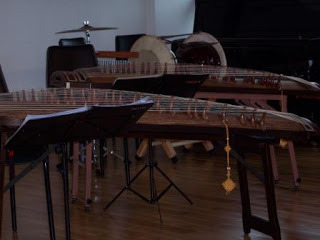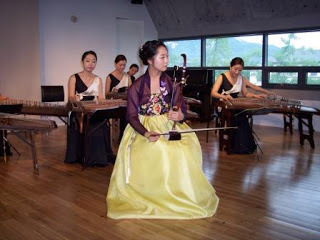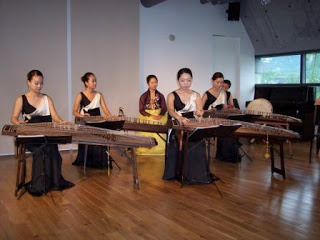Clifford Garstang's Blog, page 126
July 19, 2011
Without Borders
 Borders Books is closing? Really? Yawn. Seriously. Although I feel for the nearly 11,000 employees who will lose their jobs, and the publishers who will suffer when unsold books are returned and bills are left unpaid, I don't see how this will impact me in the slightest.
Borders Books is closing? Really? Yawn. Seriously. Although I feel for the nearly 11,000 employees who will lose their jobs, and the publishers who will suffer when unsold books are returned and bills are left unpaid, I don't see how this will impact me in the slightest.Borders didn't carry my book. I was never tempted to arrange an event at a Borders. I haven't shopped in a Borders for years (other than an attempt to bargain hunt at a store-closing sale earlier this year) and the last time I tried to do so I was horrified by the staff's lack of book knowledge. When I worked in DC, I used to visit Borders often on my lunch hour, and possibly they started losing money when I moved away. But Barnes & Noble long ago passed Borders as my favorite superstore, for inventory alone--not to mention ambiance, coffee, and competence.
And the closest Borders to me now is about 100 miles away. The Barnes & Noble branches aren't exactly close--there's one in Harrisonburg and one in Charlottesville--but they're in reach. And there are decent independent bookstores much closer. I may not be able to browse much in those stores, but they will be happy to order for me--and be polite and efficient while doing it.
So I can't get too broken up about the loss of Borders. There are plenty of problems in the book business, but Borders' wounds were self-inflicted.
Published on July 19, 2011 07:31
The New Yorker: "Matinée" by Robert Coover
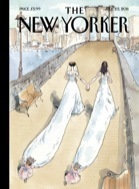
July 25, 2011: "Matinée" by Robert Coover
This story seems typical of Robert Coover. I loved his story "Going for a Beer" from earlier this year (discussed here). And I enjoyed this one, too, though not quite as much. It's a convoluted piece that keeps turning in on itself, a Möbius strip of a story with no beginning and no end. It's about old movies, but it's also about husbands and wives who are dissatisfied and looking for . . . something. On the other hand, it's about movies (stories, lives) that sometimes break. (For more on the movie motif, see Deborah Treisman's interview with Coover.) But we leave before the end anyway because we know what's going to happen, because we've seen this movie before.
A woman leaves the theater with a man she's just met, except that's in the movie that another couple has just watched, except the couple is at a bar and she's a prostitute who is also a housewife, who spends her time in the theater watching matinees, and then she leaves with a man she's just met . . .If I had unlimited time I might try to unwind the story, but I'm not sure that would add to my enjoyment of it. Coover's pretty cool.
Published on July 19, 2011 06:22
July 18, 2011
New Issue of Prime Number Magazine
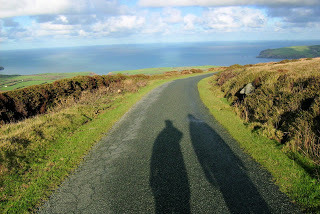 This photograph by Cath Barton is the cover of the new issue of Prime Number Magazine, which is now live.
This photograph by Cath Barton is the cover of the new issue of Prime Number Magazine, which is now live.It's a pretty terrific issue, I think, with fiction by Kevin McIlvoy, Corey Mesler, Kim Church, and many others, nonfiction by Michael Steinberg, Sheila Black, and others, and poetry by Jon Tribble, Karen Donovan, and others. We've even got some drama--a short play by Robert Moulthrop. And a couple of book reviews, including one of Eddie's War
 by Carol Fisher Saller, a contributor to the very first issue of the magazine.
by Carol Fisher Saller, a contributor to the very first issue of the magazine. There's lots to read, so please check it out!
There's lots to read, so please check it out!
Published on July 18, 2011 11:08
July 15, 2011
Days 9 & 10 -- Seoul (The End)
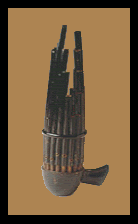 Friday was our last full day of the Korea trip. The morning's activity occurred at the Seoul History Museum, where we had musical and dramatic performances by youth volunteers (mostly precocious 12 year olds). We also had a buffet lunch (ribs!) and then free time in the afternoon. Which would have been great for last minute touring or shopping, except that it was pouring rain. So I used the time to pack and relax. We had a debriefing, and then it was time to get ready for our "formal" farewell celebration.
Friday was our last full day of the Korea trip. The morning's activity occurred at the Seoul History Museum, where we had musical and dramatic performances by youth volunteers (mostly precocious 12 year olds). We also had a buffet lunch (ribs!) and then free time in the afternoon. Which would have been great for last minute touring or shopping, except that it was pouring rain. So I used the time to pack and relax. We had a debriefing, and then it was time to get ready for our "formal" farewell celebration.This was held at the Seoul Marina and Yacht Club, a beautiful facility on Yoido Island (near the National Assembly building). I was fortunate to be included at the head table, and had a chance to speak with our host, the President of the Korea Foundation, the agency responsible for implementing these Peace Corps revisit trips. I'm glad I had a chance to express my thanks directly to President Kim.
The dinner was wonderful and so was the conversation, but there were three highlights to the event: First, a slide show presented photographs from the event, including many of our revisit photographs. Second, at the very end of the evening we all launched our "wish" lanterns -- large paper lanterns with paraffin candles on which we wrote our wishes (most had to do with peace) and then the rain paused long enough for us to launch our lanterns into the sky. It was a fun and beautiful way to end the evening and the week. But before we did that, we had a concert by a trio of amazing performers: a cellist, a pianist, and a saenghwang player. The instrument is pictured at left and I had never heard it before it. The woman who played it produced these mesmerizing, other-worldly sounds. It seems to be sort of a harmonica, but it produces tones like an oboe. Just amazing.
When we got back to the hotel, several people came to my room to work on the bottle of soju I had been given. We had a great conversations and took care of about half the bottle. That was lots of fun.
This morning, at our final breakfast, I was able to give the remainder away, and then it was time to head for the airport--in more heavy rain. But we trudged over to the bus stop, got wet, and missed the bus--but the driver saw us and stopped! So I'm now in the airport lounge, preparing for the long (and I do mean long) flight home, after a wonderful visit.
Published on July 15, 2011 19:05
July 14, 2011
Seoul -- Day 8 (continued again)
Here's another clip from the Kayagum concert.
Published on July 14, 2011 07:16
Seoul -- Day 8 (continued)
Published on July 14, 2011 07:12
Seoul -- Day 8
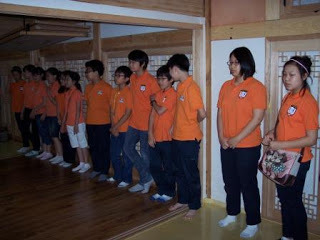
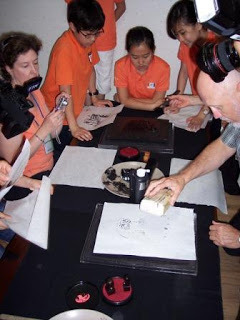 woodblock print making
woodblock print making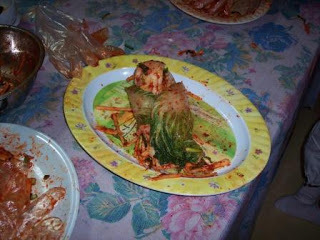 kimchi I made
kimchi I made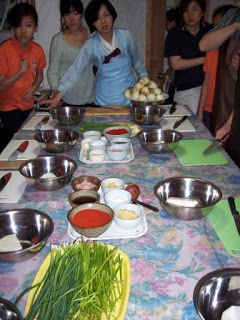 the start of the kimchi lesson
the start of the kimchi lesson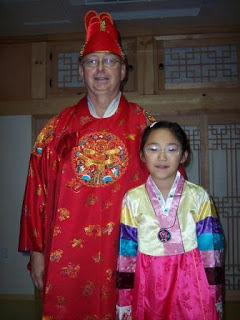 The king with his youth volunteer
The king with his youth volunteer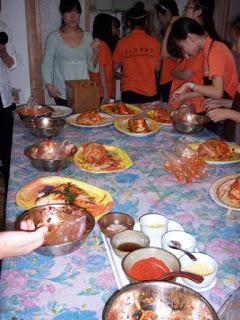 kimchi making aftermath
kimchi making aftermath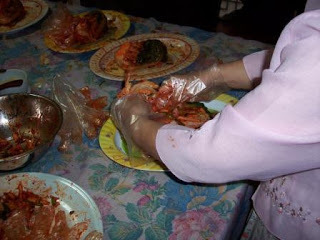 my mistakes being correctedThursday morning saw the group heading off to a traditional house in Seoul for some unusual cultural activities. We were paired with "youth volunteers" -- a group of very bright young Korean students who speak very good English. Together, we tried on traditional Korean clothing, made kimchi, and made wood block prints.
my mistakes being correctedThursday morning saw the group heading off to a traditional house in Seoul for some unusual cultural activities. We were paired with "youth volunteers" -- a group of very bright young Korean students who speak very good English. Together, we tried on traditional Korean clothing, made kimchi, and made wood block prints.After that, the kids showed us around Unhyeung Palace, one of the minor palaces of Seoul.
Published on July 14, 2011 07:07
July 13, 2011
Day 7 -- Jeonju
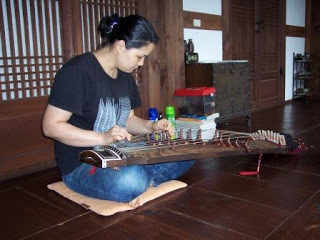 The rain finally stopped, although it was overcast. I got up early and walked around the streets of the Hanok Village--hoping I could find a cup of coffee. (I did find one place that opened at 7am, but I decided to keep walking anyway.) When I got back to the house, the owner, a kayagum teacher and performer, got out her instrument and played a couple of songs.
The rain finally stopped, although it was overcast. I got up early and walked around the streets of the Hanok Village--hoping I could find a cup of coffee. (I did find one place that opened at 7am, but I decided to keep walking anyway.) When I got back to the house, the owner, a kayagum teacher and performer, got out her instrument and played a couple of songs.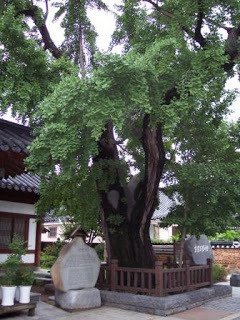 Soon Mr. Hong arrived and we went off to breakfast and then touring around this old part of Jeonju city, including a visit to an ancient Confucian school that has been in its current site for more than 400 years. There are some 400-year-old trees there, but the oldest one in the area is this 600-year-old Gingko tree. (It's "eunhaeng" in Korean.)
Soon Mr. Hong arrived and we went off to breakfast and then touring around this old part of Jeonju city, including a visit to an ancient Confucian school that has been in its current site for more than 400 years. There are some 400-year-old trees there, but the oldest one in the area is this 600-year-old Gingko tree. (It's "eunhaeng" in Korean.)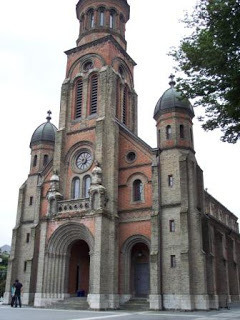 Then we visited the old Catholic church, which was built on the site of the martyrdom of early Korean Christians. I can't say that I remember coming to this church when I lived here in the 70s.
Then we visited the old Catholic church, which was built on the site of the martyrdom of early Korean Christians. I can't say that I remember coming to this church when I lived here in the 70s.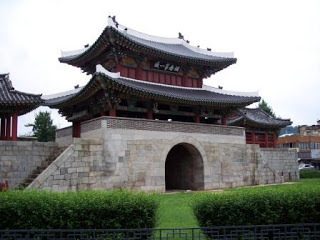 We also visited one of the gates along the wall that once fortified the city, and while I also don't remember seeing the gate in the old days, it did grace many of the brochures about local tourism back in those days. It's a pretty impressive site for a relatively small city.
We also visited one of the gates along the wall that once fortified the city, and while I also don't remember seeing the gate in the old days, it did grace many of the brochures about local tourism back in those days. It's a pretty impressive site for a relatively small city.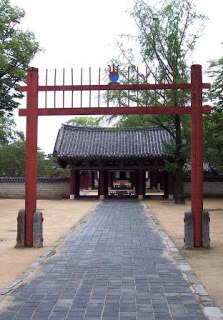 We also went to Gyeonggijeon, which is a pavilion that holds a portrait of the founder of the Joseon (Chosun) dynasty, a line that holds links to this part of Korea. (Finally, something I remember from the old days!)
We also went to Gyeonggijeon, which is a pavilion that holds a portrait of the founder of the Joseon (Chosun) dynasty, a line that holds links to this part of Korea. (Finally, something I remember from the old days!)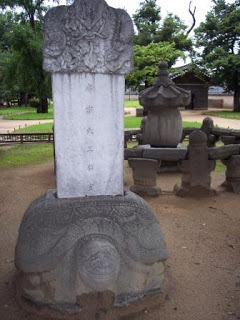 This shot is also from this complex -- it supposedly once held the king's umbilical cord.
This shot is also from this complex -- it supposedly once held the king's umbilical cord.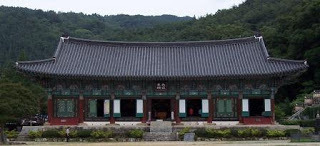 I wanted to see a local Buddhist temple, so off we went to Geumsansa (Gold Mountain Temple) Monestery which is about 20 kms. outside of Jeonju. I visited there a couple of times in the 70s. It belongs to the Maitreya school of Buddhism. It's a beautiful spot.
I wanted to see a local Buddhist temple, so off we went to Geumsansa (Gold Mountain Temple) Monestery which is about 20 kms. outside of Jeonju. I visited there a couple of times in the 70s. It belongs to the Maitreya school of Buddhism. It's a beautiful spot.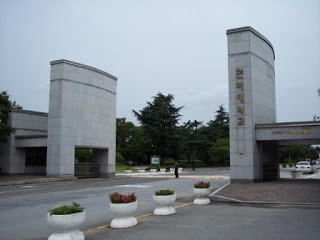 We then headed back into town to meet with an old friend of mine before taking one last look at my university on the way back to Seoul.
We then headed back into town to meet with an old friend of mine before taking one last look at my university on the way back to Seoul.And here are a couple of other random shots from the visit:
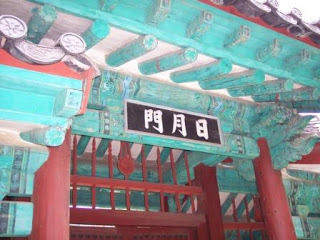 Sun Moon Gate from the Confucian School
Sun Moon Gate from the Confucian School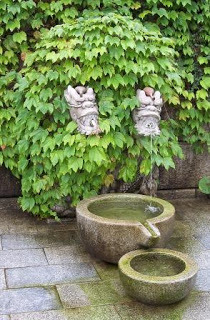 from Geumsansa
from Geumsansa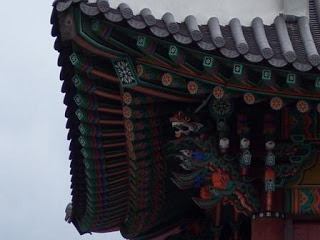 from PoongNam gate
from PoongNam gate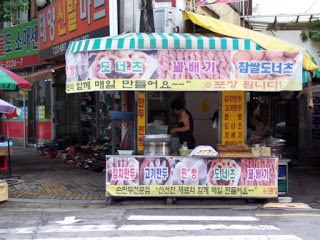 Dumpling vendor in Jeonju
Dumpling vendor in Jeonju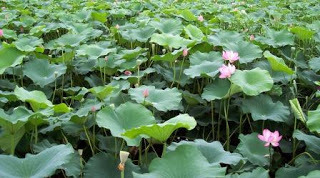 Lotus pond at DeokJin park (next to university)
Lotus pond at DeokJin park (next to university)
Published on July 13, 2011 17:02
Day 6 -- Jeonju
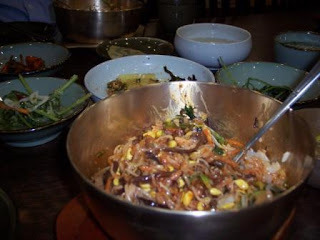 On Tuesday morning I set off for Jeonju, North Jolla Province, with a guide. I probably didn't need a guide, but Mr. Hong did make things easier, especially since he drove, so there was no hassle with public transportation. Unfortunately, the monsoon season kicked in with a vengeance, so the trip wasn't exactly scenic.
On Tuesday morning I set off for Jeonju, North Jolla Province, with a guide. I probably didn't need a guide, but Mr. Hong did make things easier, especially since he drove, so there was no hassle with public transportation. Unfortunately, the monsoon season kicked in with a vengeance, so the trip wasn't exactly scenic.Nonetheless, we arrived in Jeonju--the city where I spent 2 years teaching English in the 70s--around lunch time and set off in search of bibimbap, the dish for which the city is famous. We found a place that was recommended, and I thought it was pretty good.
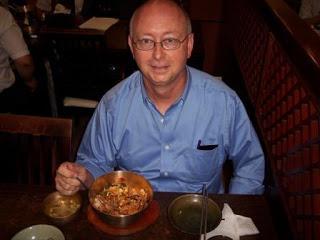 Here's me eating Jeonju bibimbap.
Here's me eating Jeonju bibimbap.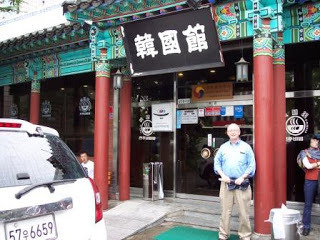 And here I am standing in front of the restaurant.
And here I am standing in front of the restaurant.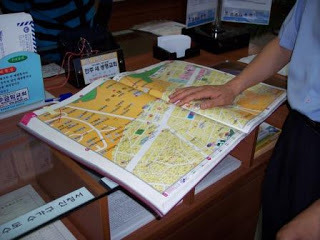 Then we wanted to find the neighborhood where I used to live. I kept saying that it was 35 years ago and i doubted that we'd find the neighborhood, much less the house, but Mr. Hong insisted. But nothing looked right, and I only had a vague idea of what my "address" was back then (and addresses were pretty vague to begin with--I didn't have a street). Eventually we stopped at the district office and the people there tried to help, but they didn't believe me when I said the main street that cut through town didn't even exist back then. Here's the office where we studied the local map.
Then we wanted to find the neighborhood where I used to live. I kept saying that it was 35 years ago and i doubted that we'd find the neighborhood, much less the house, but Mr. Hong insisted. But nothing looked right, and I only had a vague idea of what my "address" was back then (and addresses were pretty vague to begin with--I didn't have a street). Eventually we stopped at the district office and the people there tried to help, but they didn't believe me when I said the main street that cut through town didn't even exist back then. Here's the office where we studied the local map.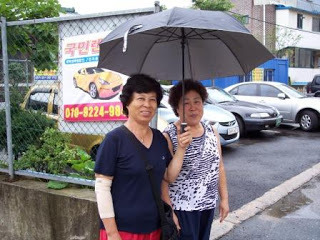 Although I was ready to give up, Mr. Hong drove around some more, but I'm sure that urban renewal took my house. But we talked to these very nice ladies about the old days, and so I do think we were in the right general vicinity.
Although I was ready to give up, Mr. Hong drove around some more, but I'm sure that urban renewal took my house. But we talked to these very nice ladies about the old days, and so I do think we were in the right general vicinity.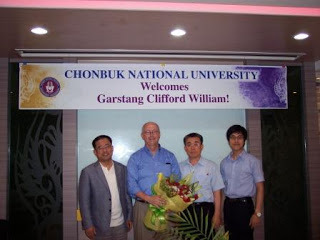 It was then time for our appointment at the university, where we met with the dean of the international affairs office. We had a nice talk and I was interviewed by a reporter from the school newspaper. We also had a campus tour, even though there's really nothing left from the old days. Chonbuk University now has 30,000 students--maybe about 6 times the number it had back in the 70s.
It was then time for our appointment at the university, where we met with the dean of the international affairs office. We had a nice talk and I was interviewed by a reporter from the school newspaper. We also had a campus tour, even though there's really nothing left from the old days. Chonbuk University now has 30,000 students--maybe about 6 times the number it had back in the 70s.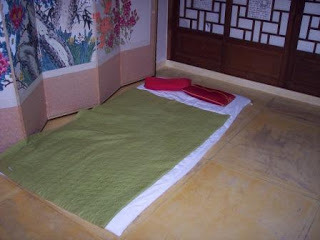 Then, in the very heavy rain, we located the place where I was to stay--a room in a traditional-style house in Jeonju's Hanok Village. Back in the 70s, everything was traditional, so this sort of place didn't exist, or rather it wasn't special. This was fun as a reminder of the old days, although sleeping on a mat on the floor I could probably have done without. Some more pictures below:
Then, in the very heavy rain, we located the place where I was to stay--a room in a traditional-style house in Jeonju's Hanok Village. Back in the 70s, everything was traditional, so this sort of place didn't exist, or rather it wasn't special. This was fun as a reminder of the old days, although sleeping on a mat on the floor I could probably have done without. Some more pictures below: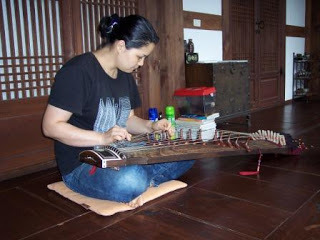 Guest house owner plays kayagum
Guest house owner plays kayagum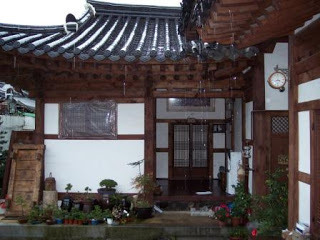 Rainy courtyard of guest house
Rainy courtyard of guest house
Published on July 13, 2011 06:43
July 11, 2011
Seoul -- Day 5
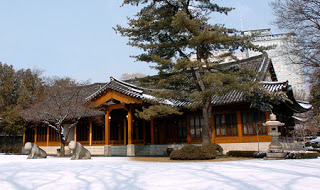 It was a great day, even though it's been raining since early morning.
It was a great day, even though it's been raining since early morning.We began with a visit to Korea's Ministry of Foreign Affairs and Trade for briefings on Korean-American relations, education policy, and health issues. We then split into two groups, with the former health volunteers visiting the Korea Foundation for International Healthcare and the education volunteers touring Yonsei University, one of the top universities in Korea.
We then went for lunch for a Korean specialty that's kind of hard to explain. It's called Sam-gey-tang, and is a chicken soup made with ginseng, chestnuts, jujubes, and other fine ingredients. (Okay, so maybe it's not so hard to explain, but that description doesn't do it justice.) Served with a glass of persimmon wine, which tastes a little like Fanta orange.
And then we headed to the next event. The American Ambassador, Kathleen Stephens, who was a Peace Corps Volunteer in Korea at the same time I was, hosted a meeting at the beautiful residence (pictures at left, although that picture is from the Embassy's website and was taken in winter; it opened while I was a volunteer in Korea in the '70s) including a briefing by officers from the economic, political, and public affairs sections of the Embassy. The Ambassador is a very impressive diplomat, and maybe some readers will be interested to see this "virtual photo book" called Kathleen Stephens' Korea 1975-77 with photos she took during her time here as a volunteer.
I hope you will also be interested in this special photo exhibition of pictures taken both by Peace Corps Volunteers and Korea International Cooperation Agency Volunteers: A Story of Volunteerism.
This evening we attended a lovely dinner hosted by the Korea Foundation, which is responsible for implementing the revisit program. They've put an enormous amount of work into the program.
Which brings us to the end of Monday. Tomorrow we're off to our respective sites, so I may not be able to post again until I return to Seoul on Wednesday evening.
Published on July 11, 2011 05:18

